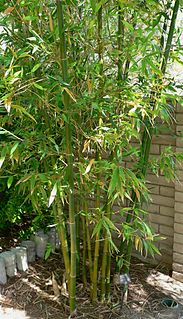
Bambusa is a large genus of clumping bamboos. Most species of Bambusa are rather large, with numerous branches emerging from the nodes, and one or two much larger than the rest. The branches can be as long as 11 m (35 ft).

Phyllostachys is a genus of Asian bamboo in the grass family. Many of the species are found in central and southern China, with a few species in northern Indochina and in the Himalayas. Some of the species have become naturalized in parts of Asia, Australia, the Americas, and southern Europe.
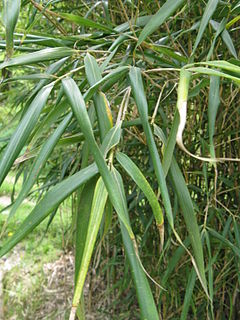
Pleioblastus is an East Asian genus of monopodial bamboos in the grass family Poaceae. They are native to China and Japan, and naturalized in scattered places in Korea, Europe, New Zealand, and the Western Hemisphere.

Chimonobambusa is a genus of East Asian bamboo in the grass family. They are native to China, Japan, Vietnam, Myanmar, and the Himalayas.

Pseudosasa is a genus of East Asian bamboo in the grass family.

Sinobambusa is a genus of East Asian bamboo in the grass family. It is native to China and Vietnam. Sinobambusa tootsik also occurs in Japan, having been introduced there during the Tang Dynasty (618–907).
- Sinobambusa baccanensisT.Q.Nguyen – Vietnam
- Sinobambusa farinosa(McClure) T.H.Wen – Fujian, Guangdong, Guangxi, Jiangxi, Zhejiang
- Sinobambusa henryi(McClure) C.D.Chu & C.S.Chao – Guangdong, Guangxi
- Sinobambusa humilaMcClure – Guangdong
- Sinobambusa incanaT.H.Wen – Guangdong
- Sinobambusa intermediaMcClure – Fujian, Guangdong, Guangxi, Sichuan, Yunnan
- Sinobambusa nephroauritaC.D.Chu & C.S.Chao – Guangdong, Guangxi, Sichuan
- Sinobambusa rubroligulaMcClure – Guangdong, Guangxi, Hainan
- Sinobambusa sat(Balansa) C.S.Chao & Renvoize – Vietnam
- Sinobambusa scabridaT.H.Wen – Guangxi
- Sinobambusa solearis(McClure) T.Q.Nguyen – Vietnam
- Sinobambusa tootsik(Makino) Makino ex Nakai – Fujian, Guangdong, Guangxi, Vietnam; naturalized in Japan including Ryukyu Islands
- Sinobambusa yixingensisC.S.Chao & K.S.Xiao – Jiangsu
Drepanostachyum is an Asian genus of medium-sized mountain clumping bamboos in the grass family. They are native to China, Indochina, and the Indian Subcontinent.
Borinda is a genus of clumping bamboos erected in 1994 by Christopher Mark Adrian Stapleton and previously included in the genera Fargesia and Yushania. They have been recognized to present different flowers and shorter rhizomes than Yushanias.

Yushania is a genus of bamboo in the grass family.
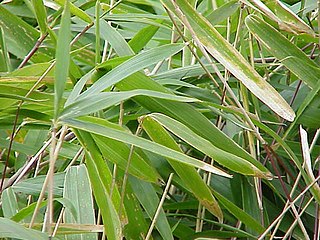
Arundinarieae is a tribe of bamboo in the grass family (Poaceae) containing a single subtribe, Arundinariinae, and 31 genera. These woody bamboos occur in areas with warm temperate climates in southeastern North America, Subsaharan Africa, South Asia and East Asia. The tribe forms a lineage independent of the tropical woody bamboos (Bambuseae) and the tropical herbaceous bamboos (Olyreae).
Neomicrocalamus is an Asian genus of bamboo in the grass family.

Acidosasa is a genus of East Asian bamboo in the grass family.
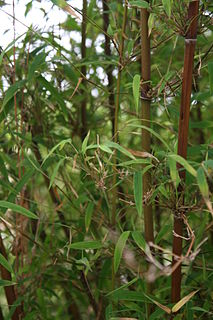
Himalayacalamus is an Asian genus of mountain clumping bamboo in the grass family. Species members are found growing at lower altitudes of the Himalaya in Bhutan, Tibet, India, and Nepal.

Fargesia is a genus of flowering plants in the grass family. These bamboos are native primarily to China, with a few species in Vietnam and in the eastern Himalayas. Some species are cultivated as ornamentals, with common names including umbrella bamboo and fountain bamboo.
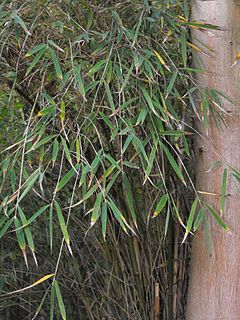
Cephalostachyum is a genus of Asian and Madagascan bamboo in the grass family.

Fargesia rufa is a woody bamboo native to western China. It is known in Chinese as qingchuan jianzhu, meaning "Qingchuan Fargesia", Qingchuan being a county within the prefecture-level city of Guangyuan in the north of Sichuan. It is found at high elevations in the north of this province as well is in the south of Gansu. The plant is a significant source of food for the giant panda.

The Bambouseraie de Prafrance is a private botanical garden specializing in bamboos, located in Générargues, near Anduze, Gard, Languedoc-Roussillon, France. It is open daily in the warmer months; an admission fee is charged.

Fargesia murielae, the umbrella bamboo, is a species of flowering plant in the family Poaceae. It is a large, clump-forming evergreen bamboo, closely resembling Fargesia nitida in the same genus, but with yellow canes.

Thamnocalamus tessellatus is a species of bamboo belonging to the family Poaceae, and endemic to the high mountains of South Africa, Lesotho and Swaziland, lying along the south-eastern part of the country. It is found in the Amatola Mountains, the Bamboesberg, which is named after it, and the Drakensberg. Its generic name means "bushy reed", while the specific name means "tiled", an allusion to the rectangular pattern of veins on the leaves. Its common names include Bergbamboes, Wildebamboes and Mountain Bamboo.
Sarocalamus is a genus of Asian bamboo in the grass family.
- Sarocalamus faberi(Rendle) Stapleton – Sichuan, Yunnan, Guizhou
- Sarocalamus racemosus(Munro) Stapleton – Tibet, Assam, Arunachal Pradesh, Myanmar, Bhutan, Sikkim, Nepal
- Sarocalamus spanostachyus(T.P.Yi) Stapleton – Sichuan
















